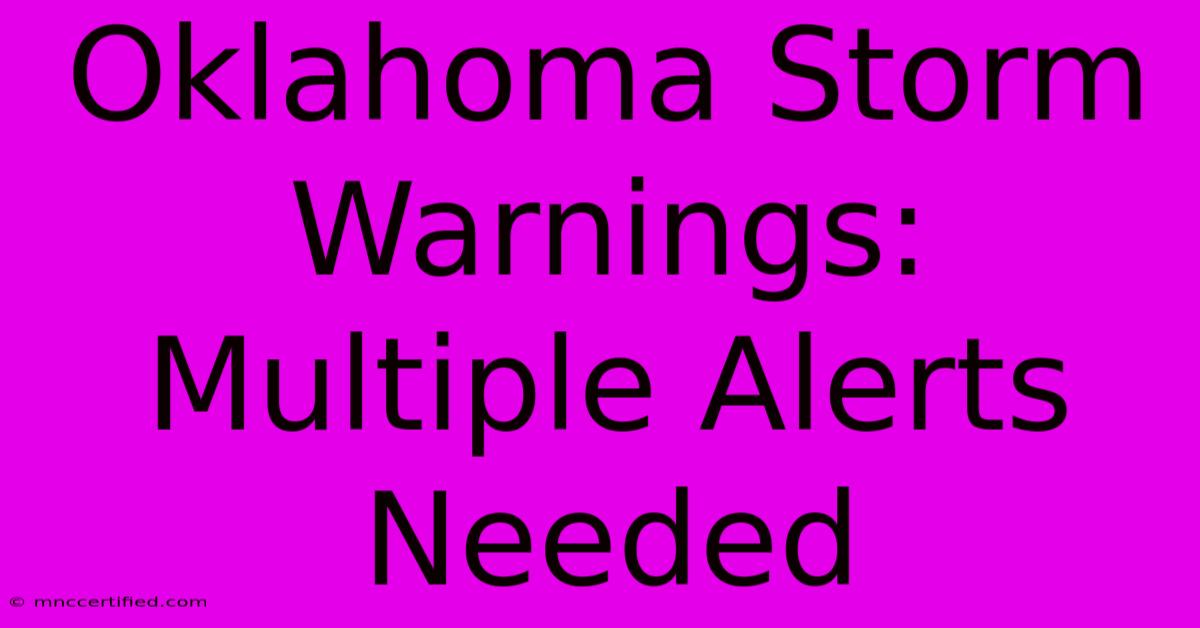Oklahoma Storm Warnings: Multiple Alerts Needed

Table of Contents
Oklahoma Storm Warnings: Why Multiple Alerts Are Often Necessary
Oklahoma, nestled in Tornado Alley, is no stranger to severe weather. The state frequently experiences powerful thunderstorms, hailstorms, and, infamously, tornadoes. This necessitates a robust warning system, and often, that means receiving multiple alerts for a single storm event. But why? Let's delve into the reasons behind the often-repeated warnings.
Understanding the Nuances of Oklahoma's Weather
Oklahoma's geography and atmospheric conditions create a perfect breeding ground for severe weather. The collision of warm, moist air from the Gulf of Mexico and cold, dry air from the Rockies generates significant instability, leading to the formation of supercell thunderstorms – the most prolific producers of tornadoes. These storms can be unpredictable, evolving rapidly and shifting course unexpectedly.
Why One Warning Isn't Enough:
-
Storm Evolution: Severe thunderstorms are dynamic systems. Their intensity, path, and associated hazards (tornadoes, hail, high winds, flooding) can change dramatically in a short time. Multiple warnings allow meteorologists to provide updated information as the storm progresses, reflecting these changes. What starts as a severe thunderstorm warning might escalate to a tornado warning as a rotation develops within the storm.
-
Improved Accuracy: The National Weather Service (NWS) utilizes sophisticated radar technology and forecasting models to track storms. However, predicting the exact path and intensity of these storms remains challenging. Multiple warnings allow for course corrections and increased accuracy as more data becomes available. Initial warnings might be broad, encompassing a larger area, while subsequent warnings can refine the affected zone.
-
Increased Lead Time: Repeated warnings, even with minor adjustments, provide residents with additional time to prepare and take shelter. This added lead time is crucial in minimizing injuries and fatalities. The extra minutes gained from multiple alerts can make all the difference.
-
Addressing Specific Threats: A single storm might pose multiple threats. One warning might address the overall severe thunderstorm threat, while subsequent warnings might focus on a newly developed tornado or a significant increase in hail size. This targeted approach ensures everyone understands the specific dangers.
-
Communication Redundancy: Multiple alerts across various platforms – weather radios, smartphones, television, and social media – ensure maximum reach. Not everyone receives information from every source, so repetition increases the likelihood of warnings reaching the intended audience.
What to Do When You Receive Multiple Storm Warnings:
Receiving multiple alerts doesn't mean the situation is worsening uncontrollably. Instead, it reflects the dynamic nature of severe weather and the ongoing efforts to keep you informed.
-
Stay Informed: Continue monitoring weather updates through reliable sources like the NWS website, weather radio, and reputable news outlets.
-
Review Warnings: Pay close attention to the specific hazards mentioned in each warning – tornado, hail, flooding, etc. This will guide your response.
-
Take Action: Don't wait for the final warning. Take protective action immediately upon receiving the initial warning. Develop a severe weather safety plan and ensure your family knows what to do.
-
Stay Alert: Remain vigilant even after the warnings expire. The threat might not have completely passed.
Keywords: Oklahoma storm warnings, multiple weather alerts, severe weather Oklahoma, tornado warnings Oklahoma, thunderstorm warnings Oklahoma, hail warnings Oklahoma, flood warnings Oklahoma, NWS Oklahoma, weather safety Oklahoma, severe weather safety, severe thunderstorm warnings, tornado safety, Oklahoma weather, weather alerts, National Weather Service.
Off-Page SEO Strategies:
- Social Media Engagement: Share this article on relevant social media platforms, encouraging discussion and engagement.
- Backlinks: Reach out to Oklahoma-based weather blogs and news websites to request links to this article.
- Community Engagement: Participate in online forums and groups focused on Oklahoma weather and safety.
By understanding why multiple storm warnings are issued, Oklahomans can better prepare for and react to severe weather events, ensuring their safety and the safety of their communities.

Thank you for visiting our website wich cover about Oklahoma Storm Warnings: Multiple Alerts Needed. We hope the information provided has been useful to you. Feel free to contact us if you have any questions or need further assistance. See you next time and dont miss to bookmark.
Featured Posts
-
I M A Celeb Barrys Shower Decision
Nov 18, 2024
-
Genesis Credit Management Lawsuit
Nov 18, 2024
-
Pre Bonded Fusion Hair Extensions
Nov 18, 2024
-
Khameneis Coma Report
Nov 18, 2024
-
How Many Zeros Are In 1 3 Billion
Nov 18, 2024